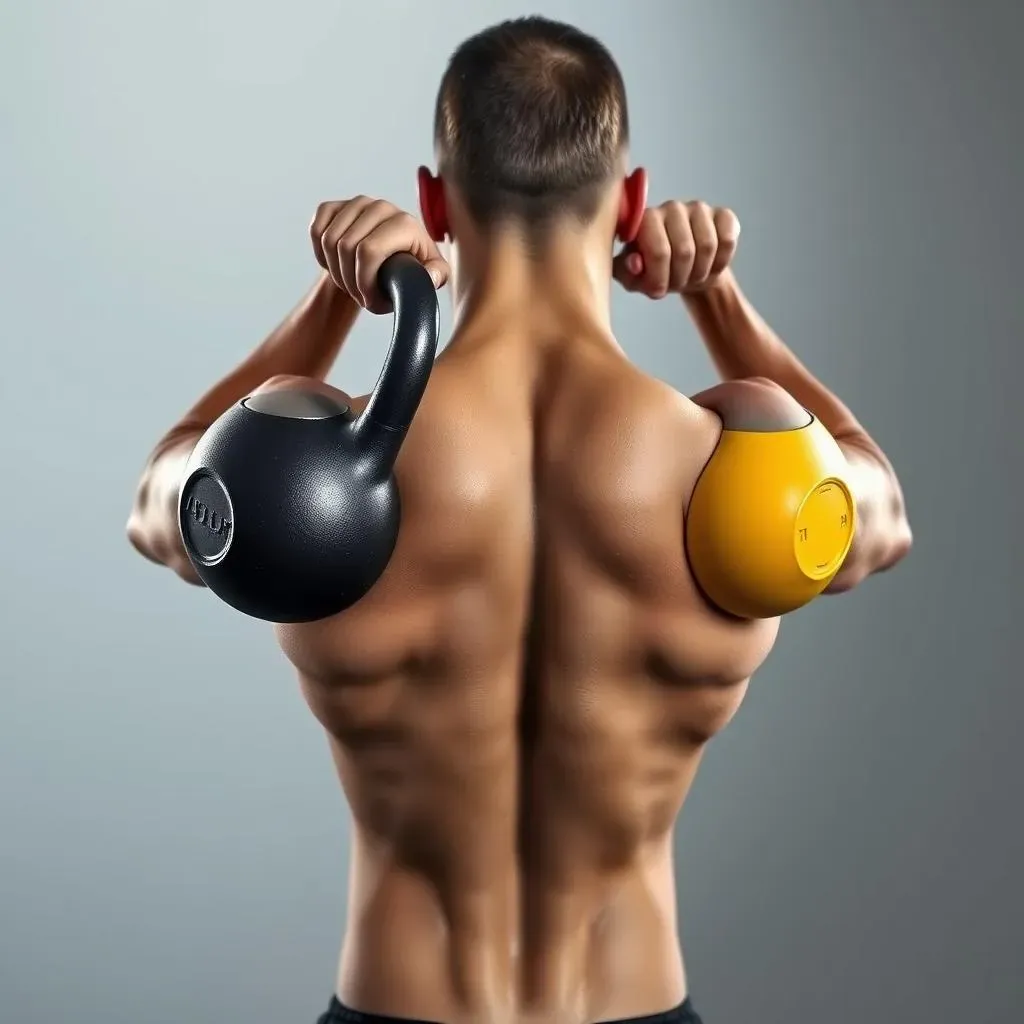Table of Contents
Ready to take your overhead pressing game to the next level? Forget those leg-drive crutches. The double kettlebell Z press is about to become your new favorite humbling exercise. This isn't your typical gym lift; it's a seated strength test that demands serious core stability, shoulder power, and a healthy dose of grit. We're diving deep into how to properly execute the double kettlebell Z press, unlocking its unique benefits, and exploring variations to keep your training fresh. Whether you're a seasoned lifter or just starting your strength journey, prepare to discover how the double kettlebell Z press can build a stronger, more resilient you. We'll cover everything from nailing the technique to avoiding common mistakes, ensuring you get the most out of this challenging exercise. So, ditch the excuses, grab your kettlebells, and let's get pressing!
Mastering the Double Kettlebell Z Press Technique

Mastering the Double Kettlebell Z Press Technique
Setting Up for Success: The Foundation of Your Z Press
Alright, let's get down to brass tacks. The double kettlebell Z press isn't just about hoisting weight overhead; it's about building a rock-solid foundation first. You'll want to start seated on the floor with your legs extended straight out in front of you. Think "L" shape with your body. Now, this is where it gets real: engage your core like you're bracing for a punch. This isn't just sucking in your gut; it's a full-body tension that keeps you stable throughout the movement. The kettlebells should be in the front rack position, resting comfortably against your forearms. Get comfortable here; you're about to earn it.
Next, focus on your posture. No slouching allowed! Sit tall, proud, and imagine a string pulling you up from the crown of your head. This upright position is crucial for proper spinal alignment and efficient force transfer. Squeeze your shoulder blades together slightly to activate your upper back muscles. This will help stabilize your shoulders and prevent them from rounding forward during the press. Remember, a strong foundation equals a strong press. Don't skip this part!
The Press: Execution and Key Considerations
you're set up, core engaged, and posture perfect. Now comes the fun part: the press itself. Initiate the movement by driving the kettlebells straight overhead, keeping your elbows tucked in slightly. Think about pressing *up* and *in*, not just straight up. This helps maintain control and keeps the weight closer to your center of gravity. As you press, focus on maintaining that rock-solid core stability. Resist the urge to lean back or use momentum to heave the weight up. This is where the Z press shines – it forces you to rely purely on upper body and core strength.
At the top of the movement, fully extend your arms and lock out your elbows. Squeeze your shoulder blades together for added stability. Hold this position for a brief moment, feeling the tension in your shoulders, triceps, and core. Then, slowly lower the kettlebells back to the front rack position, maintaining control throughout the descent. Repeat for the desired number of repetitions. Remember, quality over quantity. Focus on perfect form, and the strength will follow.
Key Aspect | Description |
|---|---|
Core Engagement | Maintain constant tension throughout the entire movement. |
Posture | Sit tall and avoid slouching or leaning back. |
Elbow Position | Keep elbows tucked in slightly during the press. |
Controlled Movement | Press and lower the weight with deliberate control. |
Benefits of the Double Kettlebell Z Press

Benefits of the Double Kettlebell Z Press
Unleashing Unmatched Core Stability
let's talk core. We all know it's important, but the double kettlebell Z press takes core stability to a whole new level. Because you're seated with your legs extended, you've eliminated any leg drive or hip hinge assistance. This means your core is working overtime to keep you upright and stable throughout the entire movement. Think of it as a moving plank – your abs, obliques, and lower back are constantly engaged, fighting to prevent you from toppling over. This intense core activation translates to improved stability in other lifts, better posture, and a reduced risk of lower back pain. It's like giving your core a full-body workout without doing a single sit-up.
And it's not just about brute strength, either. The Z press forces you to develop *active* core stability, meaning you're consciously engaging your core muscles to control movement and maintain balance. This is far more functional than passive stability, which relies on muscle stiffness alone. Active core stability is essential for athletic performance, injury prevention, and everyday activities. So, if you want a core that's not just strong but also functional, the double kettlebell Z press is your secret weapon.
Building Shoulder Strength and Stability
Beyond the core benefits, the double kettlebell Z press is also a fantastic shoulder builder. The seated position isolates the shoulder muscles, forcing them to do the majority of the work. This can lead to significant gains in overhead pressing strength and shoulder stability. The Z press also challenges your shoulder mobility, as you need to maintain a full range of motion while keeping your core engaged and your spine upright. This can help improve your overhead pressing technique and reduce your risk of shoulder injuries.
Moreover, the kettlebells add an extra layer of challenge to the exercise. The offset weight distribution of the kettlebells forces your shoulder stabilizers to work harder to control the movement and prevent the weights from drifting. This can lead to improved shoulder stability and resilience, which is crucial for anyone who performs overhead movements regularly. It's like giving your shoulders a tune-up and an upgrade all in one.
Enhancing Overhead Pressing Technique
Let's be real: a lot of people cheat on their overhead presses. They use leg drive, lean back, and generally contort their bodies to get the weight up. The double kettlebell Z press eliminates all of that nonsense. Because you're seated, you can't use your legs or hips to generate momentum. You're forced to rely purely on your upper body strength and core stability to press the weight overhead. This forces you to use proper form and technique, which can translate to improvements in other overhead pressing exercises.
Think of the Z press as a "reset" for your overhead press. It strips away all the compensations and bad habits, forcing you to rebuild your technique from the ground up. This can be especially beneficial for people who have been struggling with their overhead press or who have a history of shoulder injuries. By mastering the Z press, you can develop a stronger, more efficient, and safer overhead press technique. It's like going back to basics and learning to press the right way.
Benefit | Description |
|---|---|
Core Stability | Intense core activation for improved stability and posture. |
Shoulder Strength | Isolation of shoulder muscles for increased strength and stability. |
Technique Enhancement | Elimination of compensations for improved overhead pressing form. |
Double Kettlebell Z Press Variations and Alternatives

Double Kettlebell Z Press Variations and Alternatives
Single Kettlebell Z Press: A Great Starting Point
New to the Z press game? Or maybe you're just looking to refine your technique? The single kettlebell Z press is your friend. By using just one kettlebell, you reduce the overall load and allow yourself to focus on proper form and core engagement. This variation is excellent for building a solid foundation before progressing to the double kettlebell version. Plus, it throws in an extra challenge for your obliques as they work overtime to prevent you from tipping to one side. Think of it as Z press training wheels – essential for mastering the basics.
To perform the single kettlebell Z press, follow the same setup instructions as the double kettlebell version, but hold only one kettlebell in the front rack position. Focus on maintaining a stable and upright posture throughout the movement, resisting the urge to lean to the side. Start with lighter weight and gradually increase the load as your strength and stability improve. Remember, quality over quantity. Perfect your form with the single kettlebell before moving on to the double.
- Easier to manage than double kettlebells.
- Great for learning proper form.
- Challenges your obliques for added core work.
Dumbbell Z Press: Accessible and Versatile
Don't have kettlebells? No problem! The dumbbell Z press is a fantastic alternative that offers many of the same benefits. Dumbbells are more readily available in most gyms, making this variation accessible to a wider range of people. Plus, dumbbells can be easier to grip and control, especially for those with smaller hands. The dumbbell Z press is a great way to build upper body strength, core stability, and improve your overhead pressing technique, all without needing specialized equipment.
To perform the dumbbell Z press, follow the same setup instructions as the kettlebell version, but hold a dumbbell in each hand. Focus on maintaining a neutral wrist position and avoiding any excessive wrist flexion or extension. Press the dumbbells straight overhead, keeping your elbows tucked in slightly. As with the kettlebell version, focus on maintaining a rock-solid core and avoiding any leaning or momentum. The dumbbell Z press is a versatile and effective exercise that can be easily incorporated into any strength training program.
Landmine Z Press: A Unique Angle on Strength
Want to spice things up and challenge your body in a new way? The landmine Z press is an intriguing variation that offers a unique angle on strength training. By using a landmine setup (a barbell anchored at one end), you introduce a diagonal pressing pattern that engages your muscles in a slightly different way. This can help improve your pressing power, shoulder stability, and core strength, all while adding some variety to your training routine. The landmine Z press is a great option for those looking to break through plateaus and add some excitement to their workouts.
To perform the landmine Z press, set up a barbell in a landmine attachment or wedge it into a corner. Load the opposite end of the barbell with weight. Sit on the floor with your legs extended in front of you, facing the loaded end of the barbell. Grip the barbell with one hand, keeping your elbow close to your body. Press the barbell up and forward, maintaining a stable core and avoiding any twisting or leaning. Lower the barbell back to the starting position with control. Repeat for the desired number of repetitions, then switch sides. The landmine Z press is a challenging but rewarding exercise that can add a new dimension to your strength training.
Variation | Benefits |
|---|---|
Single Kettlebell Z Press | Easier to manage, great for learning form, challenges obliques. |
Dumbbell Z Press | Accessible, versatile, good for grip strength. |
Landmine Z Press | Unique angle, improves pressing power, adds variety. |
Muscles Worked and Common Mistakes in the Kettlebell Z Press

Muscles Worked and Common Mistakes in the Kettlebell Z Press
Targeted Muscles: A Full-Body Affair
Don't let the seated position fool you; the kettlebell Z press is far from a lazy exercise. It's a full-body engagement that targets a surprising number of muscles. Primarily, you're hitting your shoulders (deltoids), triceps, and upper back (trapezius and rhomboids) as you press the weight overhead. However, the real magic happens in your core. Your abdominals, obliques, and lower back muscles are working overtime to stabilize your spine and prevent you from toppling over. Even your hip flexors get in on the action, helping to maintain that seated "L" position. It's a symphony of muscle activation, all working together to achieve a seemingly simple movement.
Think of it this way: your shoulders and triceps are the prime movers, responsible for pressing the weight. Your upper back provides stability and prevents your shoulders from rounding forward. And your core is the unsung hero, holding everything together and allowing you to generate maximum force. It's a true testament to the interconnectedness of the human body. When you perform the kettlebell Z press correctly, you're not just building strength; you're building a more resilient and functional physique.
Common Pitfalls: Avoiding Z Press Faux Pas
Alright, let's talk about mistakes. Because let's face it, everyone makes them. But knowing what to avoid is half the battle. One of the most common errors in the kettlebell Z press is leaning back during the press. This turns the exercise into more of an incline press and takes the emphasis off your core. Resist the urge to cheat! Keep your torso upright and your core engaged throughout the entire movement. Another frequent mistake is flaring your rib cage. This compromises your core stability and can lead to lower back pain. Keep your ribs tucked in and your core braced.
Also, many people fail to maintain proper shoulder position. They allow their shoulders to round forward, which puts them at risk of injury. Squeeze your shoulder blades together slightly to activate your upper back muscles and stabilize your shoulders. And finally, don't use too much weight too soon. Start with a lighter load and gradually increase the weight as your strength and technique improve. Remember, it's better to do the exercise correctly with lighter weight than to butcher the form with a heavier load.
Mistake | Consequence | Solution |
|---|---|---|
Leaning Back | Reduced core activation, improper muscle engagement. | Keep torso upright, engage core. |
Rib Flare | Compromised core stability, lower back pain. | Tuck ribs in, brace core. |
Rounded Shoulders | Increased risk of injury, poor posture. | Squeeze shoulder blades together. |
Too Much Weight | Compromised form, increased risk of injury. | Start with lighter weight, gradually increase load. |
Perfecting Your Form: Tips for a Stellar Z Press
So, how do you avoid these common mistakes and achieve Z press perfection? First, focus on your setup. Spend some time getting into the correct position, engaging your core, and setting your shoulders. This will set the stage for a successful press. Next, visualize the movement before you even begin. Imagine pressing the weight straight overhead, maintaining a stable core, and avoiding any leaning or twisting. This mental rehearsal can help improve your technique and prevent errors.
Also, consider filming yourself performing the exercise. This can help you identify any areas where your form is breaking down. Compare your technique to videos of experienced lifters performing the Z press. And finally, don't be afraid to ask for help from a qualified coach or trainer. They can provide personalized feedback and help you refine your technique. With a little practice and attention to detail, you can master the kettlebell Z press and reap its many benefits.
Conclusion
The double kettlebell Z press is more than just a challenging exercise; it's a potent tool for building serious overhead strength, core stability, and shoulder resilience. By mastering the technique, understanding the benefits, and incorporating variations, you can unlock a new level of performance in your pressing game. So, embrace the challenge, ditch the momentum, and let the Z press forge a stronger, more stable you. Now go get after it!